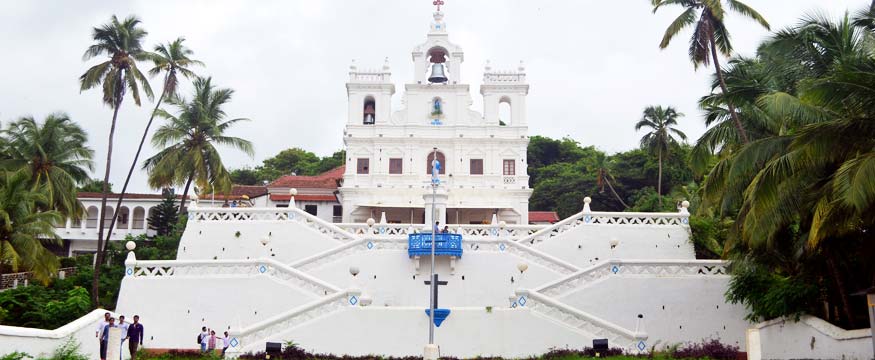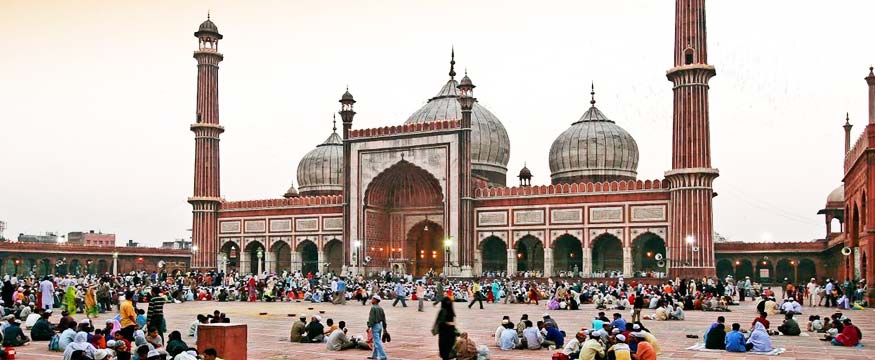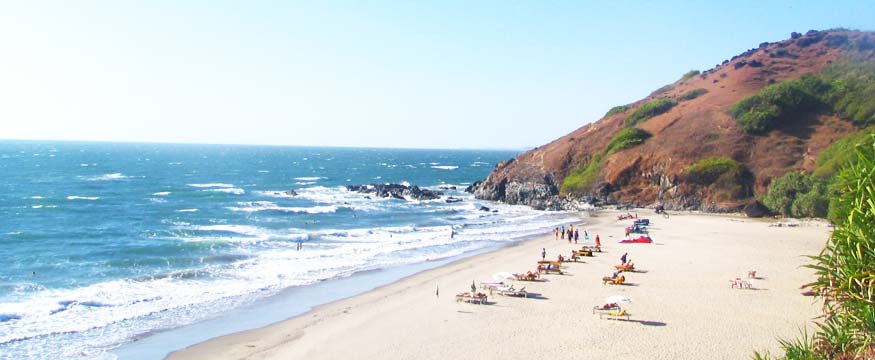Romance of Royalty and Beaches
13 Nights Itinerary Covering: Delhi - Agra - Jaipur – Udaipur - Goa - Delhi
Romance of Royalty and Beaches 13 Nights / 14 Days
13 Nights Itinerary Covering: Delhi - Agra - Jaipur – Udaipur - Goa - Delhi
Overview
Royalty isn’t merely a six-letter-word; it has immense power of captivity. And in this tour, you are going to experience and witness an unforgettable extravaganza of grandiose, art, beauty and tales through famous monuments of Rajasthan, Delhi, Agra like The Taj Mahal (One of the Seven Wonders of the World), Red Fort, Qutb Minar, Amer Fort, City Palace Udaipur and many others. Historians would love to visit ancient city of Fatehpur, which was built by Mughal Emperor Akbar with much dedication- as it is evident through its buildings and plan. Once you are done with indulgence in royalty, beaches and monuments of Goa would await you. Here, you can enjoy your favorite water-sports or just relax in serene beaches. The Churches and Convents of Goa would flaunt a perfection of architecture and inspiring histories along with spirituality.
Note: This is just a suggested itinerary indicative of what could be possible. We tailor holidays for your specific needs. Contact us if you want modifications so that we could tailor a holiday to suit your need for an unforgettable India tour.
Highlights
- Visit topmost attractions of capital city, Delhi, like Jama Masjid and Qutub Minar.
- Explore one of the Seven Wonders of the World, Taj Mahal.
- Take an elephant ride to reach the hill-fort, Amer Fort of Jaipur.
- Spend some serene moments, boating on Udaipur’s lake and visiting its beautiful forts and palaces like City Palace.
- Praise the glory of Goa’s churches and convents, which includes Se Cathedral, Church of Our Lady of Immaculate Conception.
- Relax or try your favorite water sports in the beaches of Goa.
Itinerary - Romance of Royalty and Beaches
On your arrival in Delhi Airport/ Railway Station you are greeted by our tour representative who further escorts you to your pre-booked hotel. New Delhi, the capital of India, flaunts an amalgamation of old and new. The city satisfies the demands of a foodie, shopper and most of all, an explorer. From Mughals to British, New Delhi was delightfully adorned by its erstwhile rulers with several structures, many of which are considered an epitome of India's culture.
As you reach your hotel, check-in and relax. Spend the rest of the day at leisure. Stay overnight in the hotel.
This day you set to explore Delhi. Jama Masjid, Red Fort, Chandni Chowk, Raj Ghat, Cremation Site of Mahatma Gandhi, Jama Masjid, Laxminarayan Temple and Qutub Minar are included in the list of things to do today.
Jama Masjid is the largest fort of India and most definitely a highly revered Islamic shrine. It was built by Emperor Shah Jahan between 1644 and 1658 AD. More than 25000 people can gather at once in its courtyard. It has some semblance to Badshahi Masjid of Lahore, Pakistan. Minarets, domes and arches are most notable features of the mosque, which is mainly built from red sandstone and white marble. About 5000 workers were employed to craft this masterpiece. An approximate amount of one million rupees was used for its construction, during that time. During Islamic festivals like Eid, the mosque looks even more incredible.
Red Fort is a symbol of India's culture, history and nationalism. It happens to be the venue of the celebration of India's independence. The Prime Minister of India hoists the Indian national flag at its front. The fort served as a residence for Mughal rulers for about 200 years. Just like Jama Masjid, Red Fort too was built by Shah Jahan, in 1648. UNESCO inscribed the name of this fort as a World Heritage Site. A fusion of Islamic, Hindu, Persian and Timurid styles of architecture was incorporated in its construction.
Chandni Chowk is located in Old Delhi and attracts myriad of travelers with the power of its food, market and the old-world charm. From stationary to spices, everything is available in this market, at cheap prices. In fact, Chandni Chowk's street food is very popular in all of Delhi; people come from different regions of the city just to treat their taste-buds.
Raj Ghat was built in the memory of the Father of the Nation, Mahatma Gandhi. It is located on the banks of River Yamuna, and the road too is named Mahatma Gandhi Road. Samadhi of Jawaharlal Nehru is located to its north and is named Shantivan.
Laxminarayan Temple is a highly revered temple complex of the city. It is dedicated to Hindu god, Vishnu and dates back to 1933. The complex has other temples dedicated to Lord Krishna, Lord Shiva and Buddha.
Qutub Minar, a UNESCO World Heritage Site, was commissioned in 1193 by Qutb-ud-din Aibak. Verses of the Quran are inscribed on the walls. The tower is 75.5 meters tall, with 379 steps. Red sandstone was mainly used in the construction. Qutub Complex is dotted with several other archeological monuments like Qubbat-Ud-Din-Aibak and Alai Darwaza.
Overnight stay in hotel.
In the morning drive to Agra. On reaching, check-in at your luxurious hotel. After freshening up, prepare to visit one of the Seven Wonder of World, a UNESCO World Heritage Site, Taj Mahal. Other sites to be visited are Itmad-ud-Daulah.
Taj Mahal is immensely impressive and epitomize true love and brilliant architecture. Mughal Emperor Shah Jahan commissioned Taj Mahal in 1632. It took about 22 years for the completion of this structure. Taj Mahal is built from white marble and it took about twenty thousand workers to sculpt this masterpiece. Its symmetrical precision too is highly acknowledged. Quran's verses are inscribed on different walls of Taj Mahal. The gate has twenty two small domes and the most notable dome is the Tomb of Mumtaz Mahal. Inlay work of semi-precious stones are used for interior décor of the Mahal.
Itmad-ud-Daulah tomb is often called "Jewel Box" or "Baby Taj". This is a mausoleum of Mirz? Ghiy?s Beg, built between 1622 and 1628 and was commissioned by Nur Jahan (wife of Jahangir). Just like Humayun's Tomb of Delhi and Akbar Tomb in Sikandra, this too is built from red-sandstone and white marble. It is located on the banks of Yamuna River, amid a large cruciform garden with meandering water courses and pavements. Hexogonal towers on each of its corners add on to the beauty of architecture. Intricate jali work on the marble also helps light enter the interior.
Return to the hotel and Stay overnight.
On the 4th day Tour, you will start your journey from Agra to Jaipur by road. On the way, En-route, halt at the World Heritage Site of Fatehpur Sikri, sandstone city that was laid down by Mughal Emperor Akbar.
It has some of the most amazing structures that are worth-visiting. Explore the huge Jama Masjid, Buland Darwaza- the largest gateway in the world, the historical Jodha Bai Palace, Birbal Bhavan, Panch Mahal etc.
Thereafter, continue your tour from Agra to Jaipur, the capital city of Rajasthan.
Jaipur is known as Pink City. Maharaja Sawai Madhopur founded it in 1727. He and different other rulers dotted the city with several royal marvels like Hawa Mahal, Amber Fort and Nahagarh Fort. The city is an exposition of culture, history and a vibrant collection of handicrafts, artifacts etc. Jaipur, along with other cities of Rajasthan, has seen a tremendous growth in destination weddings of royal and wealthy families of India and abroad. Art and craft of Jaipur is yet another notable aspect of this city. Miniature paintings, blue pottery, kundan, gems, bandhani, ivory carving, stone carving, meenakari, block printing and leatherware are few popular crafts of the city.
Stay overnight.
Today is set for a sightseeing session of Jaipur, which includes Amber Fort and other local sites. Amber Fort or Amer Fort is perched on a hill-top and overlooks a spectacular view of the city and Maota Lake. The fort receives about 5000 visitors from across the world in a single day. Red stone and marbles were generally used for its construction. It was built in 1592 by Raja Man Singh and has been declared a World Heritage Site by UNESCO, as Hill Forts of Rajasthan. Most of its elements represent Hindu style, which is quite notable. To climb up-hill, one can choose to walk by foot, take an elephant ride or hire jeep. Diwan-e-khas, Sheesh Mahal, Sukh Niwas and Diwan-e-aam are some of the most acclaimed structures of the fort.
Other sites to visit might include Hawa Mahal, City Palace and Museum and Jantar Mantar etc. Hawa Mahal literally means the Palace of Breeze and this christening owes to the several windows of the palace that collectively looks like a honeycomb. These windows were built for the ladies of royal household, so they could enjoy the hustle and bustle of the market, without getting seen by the locals. World's largest sundial can be seen in Jantar Mantar. There are several other instruments placed here that are of utmost importance to astrological studies and practices. The City Palace is the former seat of Maharaja of Jaipur and was built in 1732, flaunting a fusion of Indian, Mughal and European architectural styles.
Return to your room. Overnight stay in hotel.
On 6th day, proceed to Rajasthan's one of most beautiful and romantic cities, Udaipur. On reaching, check in at your luxurious hotel. From 6th to 8th day, prime attractions of Udaipur are to be visited. Some of the best attractions of Udaipur are City Palace, Lake Palace, Saheliyon ki bari, Lake Pichola, Fateh Sagar Lake, Jagdish Temple and Monsoon Palace among others.
Udaipur or Lake City is often called Venice of the East. Travel+ Leisure rated Udaipur as The Top city, in its World's Best Award in 2009. Rajasthani and Mughal architecture adorn the city and make it the one-of-its kind. The lakes further add to the glint and charm. Fateh Sagar Lake, Udai Sagar Lake and Lake Pichola are counted as some of most beautiful lakes in India. The city was founded by Maharana Udai Singh in 1559. Udaipur is host to several destination weddings of heritage style. Also, its crowd-magnetism is not confined to boundaries of India; people around the world are attracted by its beauty.
Evening can visit the local Overnight stay in the hotel.
Today morning after breakfast go out for sightseeing of Udaipur .
City Palace dates backs to 1559 and is very famous attraction of Udaipur. The structure looks magnificent and is considered to be largest of its kind in the state of Rajasthan. Movies like James Bond Octopussy and Goliyon ki Raasleela Ram-Leela have featured this palace. Manak Mahal, Laxmi Vilas, Krishna Vilas, Jagdish Mandir, Fateprakash Palace, Durbar Hall, Amar Vilas, Badi Mahal and the gateways are notable features of City Palace. In its museum, Zanana Mahal (ladies chamber) houses a collection of interesting exhibit like a monkey holding a lamp and portraits of maharajas displaying their fabulous mustaches.
Saheliyon Ki Bari – the courtyard (garden) for the maids of the Queen, Jagdish temple – a temple dedicated to Lord Vishnu, formerly known as the temple of Jagannath Rai.
Monsoon Palace or Sajjan Garh Palace was built in 1884 and by Maharana Sajjan Singh. It is situated in a hill-top at an elevation of 944 m and overlooks sparkling lakes, forts and palaces of the city. It was built to enjoy the view of monsoon clouds; hence it was named Monsoon Palace. Also, the king loved to behold the sight of his ancestral home of Chittaurgarh from here. The palace is built from white marble. As the sun sets down the horizon, the palace gets decorated with lights. Motifs of leaves and flowers are found her in abundance. Encircling the palace is yet another attraction of Jodhpur, Sajjangarh Wildlife Sanctuary which was established in 1987 and covers an area of 5.19 sq km.
Evening enjoy boat ride in Lake Pichola.
Overnight stays in hotel.
Today morning after breakfast go out for an excursion to Ranakpur. Ranakpur is located between Jodhpur and Udaipur in a valley on the western side of Aravali Hills in Rajasthan and can be easily accessed by road from Udaipur. It is one of the most well-known pilgrimage sites of Jainism in Rajasthan. This exceptionally beautiful temple was built during the reign of Rana Kumbha. Ranakpur not only to pilgrims but also to witness this fine example of Jain architecture.
Later back to Udaipur , enjoy your shopping in the markets.
Overnight stay in Udaipur.
After the captivity of lakes, royal forts and palaces of Udaipur, exotic beaches of Goa await you. On 9th day, have your breakfast and fly to Goa via New Delhi. Reach Goa by afternoon and have lunch. Check-in at your luxurious hotel. In the evening, enjoy the sunset view from an exotic Goan Beach. From day 9 to 13, prepare to explore the best of Goa. Some popular attractions of Goa, to be visited are Church of Our Lady of Rosary, Church of St. Francis of Assisi, Church of Our Lady of Rosary, The Se Cathedral and Basilica of Bom Jesus, among others.
Goa has some spectacular churches and convents, some of which have been listed as UNESCO World Heritage Site with the name of Churches and Convents of Goa. Some monuments added to this list are Se Cathedral, Immaculate Conception Church, Church of St. Francis of Assisi and others.
Immaculate Conception Church or Our Lady of the Immaculate Conception Church was built as a chapel by Portuguese rulers in 1541. It was later converted into a larger church. Baroque architecture style is main inspiration behind this super-white structure. Interior is colorful and the main altar is decorated in the honor of Mary. The large belfry on the façade was retrieved from a monastery. Masses here take place every day in English, Konkani and Portuguese language.
Se Cathedral is also known as Se Cathedral de Santa Catarina. It is the largest church of India and is dedicated to Catherine of Alaxandria. In 1510, Se Cathedral was built to mark the victory of Portuguese over a Muslim army. The notable feature, Golden Bell, is installed on the tower. Scenes from the life of Saint Catherine are interpreted through carving on six main panels. Saint Francis Xavier, the patron saint of the state used the baptismal font to baptize Goan converts around 1532.
Church of St. Francis of Assisi was also built by the Portuguese, in 1661. This served as a palace for Archbishops. The structure is lime-plastered and is built of laterite blocks. Tuscan order style is adopted in its exterior and the entrance is embellished in Manuline style. The convent houses a museum which was set up by Archeological Survey of India and displays a collection of paintings, sculptures and artifacts; all these exhibits narrate tales of Goa's rich history.
You must also spend some time in some of Goa's best beaches like Baga Beach, Anjuna Beach, Candolim Beach and others. You may opt to relax or try your favorite water sports like surfing, jet-skiing, parasailing and windsurfing. Shop at Goa's bustling markets like Calangute Bazaar, Anjuna Flea Market and Saturday Night Market.
Overnight stays in your luxury hotel.
Have your breakfast and check out from your hotel. Today, you get a timely transfer to Dabolim Airport (Goa), from where you catch a flight for New Delhi International Airport, so that you can continue your onward journey.



